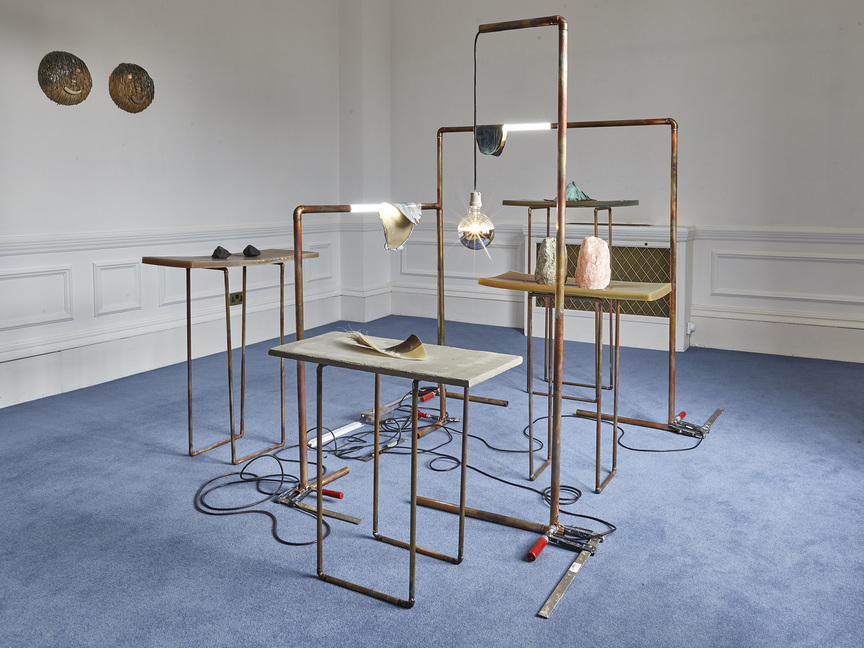-
From Current Issue
-
- Editor’s Letter Fire in the Heart
- Reviews I Gusti Ayu Kadek Murniasih
- Reviews 11th Seoul Mediacity Biennale: “One Escape at a Time”
- Dispatch Networked China
- One on One Monira Al Qadiri on Yukio Mishima
- Essays The rise of independent art spaces in pandemic-era Shanghai
- Features Tuan Andrew Nguyen
- Table of Contents
- Web Exclusives
- Archive
- Subscribe

R
E
V N
E
X
T
Installation view of KENTARO YAMADA’s “Everything Comes in Waves,” at Daiwa Anglo-Japanese Foundation, London, 2019. All images copyright the artist; courtesy the artist and Daiwa Anglo-Japanese Foundation, London.
In the work of Kentaro Yamada, objects often have a story. Sometimes, they even possess subjectivity, as in the video No Title (2014), featuring a 250-million-year-old salt rock crystal and a man-made concrete replica only 24-hours-young. In a text exchange between these protagonists, the salt rock contemplates the yawning age gap between itself and its concrete replica, and bemoans, “Humans are just kids compared to how long I’ve been around. Yet they think they own the world.”
The two sentient rocks appeared in the flesh in Yamada’s exhibition “Everything Comes in Waves,” at London’s Daiwa Anglo-Japanese Foundation. They were part of a larger, untitled installation (2014–19) of an eccentric configuration of stoneware platforms held up by copper tubing. Objects of different materials were placed on the platforms or hung on the tubing, with a deliberate precision reminiscent of a ritual arrangement. Yamada similarly envisions these displayed objects as beings with histories. For instance, a pair of rocks sourced from Germany and New Zealand are noted to be “well travelled” in the medium description of the artwork label, stressing as the objects’ material identity their accumulated worldly experience. Also on display were ceramic and volcanic matter, materials of particular interest for Yamada for the ways they have shaped Japanese pottery practices (his father is a traditional Japanese potter). In Yamada’s approach to objects, there is a turn away from anthropocentrism that aligns with recent object-oriented ontologies, whose principles feel particularly provocative in our so-called era of the Anthropocene.
A sense of life is similarly projected onto objects in Everything Comes in Waves (2011), a light installation comprising 44 incandescent light bulbs strung on black electrical cords, which have been arranged in concentric circles on the floor. The bulbs brighten and dim to mimic the rhythm of Cheyne-Stokes respiration, an abnormal breathing pattern characterized by alternating periods of suspended breathing and hyperventilation, a cyclical pattern of crescendos and diminuendos. The metaphor of illumination as life is constructed in a similar manner in Mona Hatoum’s Undercurrent (red) (2008), a floor-prone installation of interwoven red cables connected to dozens of light bulbs that brighten and subside to match a regular breathing pace. Yamada’s version, however, reflects not so much life as its constitutive precariousness. Cheyne-Stokes breathing has been observed in people nearing death, as Yamada had witnessed in an ailing family member; in such instances, each time the breathing halts is a period of uneasy suspense, since it is possible that the cycle will cease—or has already ceased. But with Yamada’s work, any sense of peril is short-circuited, since viewers can expect its lights to remain in a programmed loop, that any malfunctions will be duly fixed, and its life cycle indefinitely extended. The art object twins the human, but it stands placidly impassive against human fragility.
More visually subdued yet exerting a greater pull was Tsunami No. 1–3, Triptych (2011– ), two sets of three framed prints that hung on adjacent walls. One grouping depicts aerial views of the 2011 tsunami off Japan’s Tohoku coast, freezing a moment in the wave’s course toward catastrophic destruction. The images are screenshots taken from televised footage; this feels poignant, as it is often in the form of mass-circulated imagery that traumatic histories coalesce and persist in collective memory. The dyeline blueprint technique used to produce the prints imparts them with a gray undertone and a softness that recalls some of Hiroshi Sugimoto’s meditative seascapes. But if Sugimoto’s expansive series possess a sense of oneiric timelessness, Yamada’s work is haunted by the passage of time. Tsunami’s second set of three prints are identical to the first, but printed eight years ago and thereafter exposed to light, causing the blues of their surfaces to wash out to beiges, within which the contours of the waves are now barely visible. In this dissolution, metaphors may be posited regarding the vulnerability of the image, or of memory. But a more powerful one stems from the work’s materiality—the chemical alteration of the image as a mirror for the Fukushima Daiichi nuclear disaster triggered by the tsunami, and its persisting biochemical aftereffects, which remind us of matter’s long history.
Kentaro Yamada’s “Everything Comes in Waves” is on view at the Daiwa Anglo-Japanese Foundation, London, until July 26, 2019.
To read more of ArtAsiaPacific’s articles, visit our Digital Library.



















